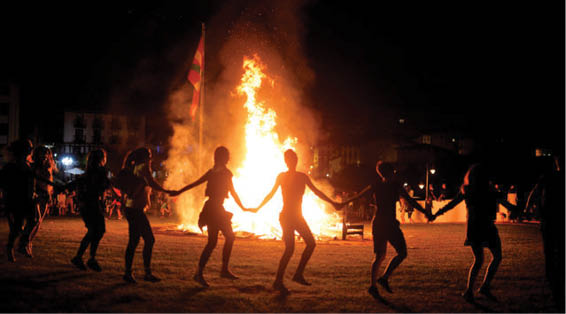
As joyful Christian countries around the world get ready to celebrate Christmas, all streets, stores and houses are decorated with lights for the glorious festive season. One hears Christmas carols and X’mas cheer everywhere – and some people even wear Christmas jumpers!
For Iranians around the world, it’s a little different, because they are getting ready for one of their most important nights of the year – Yalda Night, authentically known as ‘Shab-e-Chelleh’. For the majority of Iranians Yalda Night holds great religious relevance and it is celebrated with equal zest all over the streets of Iran.
 So, what is Yalda Night? The word ‘Yalda’ literally means ‘birth’. Yalda Night is a beautiful ancient Iranian celebration where Iranians celebrate the longest and darkest night of the year or winter solstice. This night falls on the 20th or the 21st of December, according to the Georgian calendar. In Iran, a different calendar – the Iranian calendar – is used. According to this calendar, Yalda Night is the last evening of the autumn day or ‘the night opening the initial forty-day period of the three-month winter’.
So, what is Yalda Night? The word ‘Yalda’ literally means ‘birth’. Yalda Night is a beautiful ancient Iranian celebration where Iranians celebrate the longest and darkest night of the year or winter solstice. This night falls on the 20th or the 21st of December, according to the Georgian calendar. In Iran, a different calendar – the Iranian calendar – is used. According to this calendar, Yalda Night is the last evening of the autumn day or ‘the night opening the initial forty-day period of the three-month winter’.
The celebration of the Yalda Night exists from the time when a majority of Persians were followers of Zoroastrianism, prior to the advent of Islam. Ancient Persians believed that evil forces were dominant on the longest night of the year, and that the next day belonged to the Lord of Wisdom, Ahura Mazda.
This night has been used in many Iranian poems to describe a dark night in which one gets separated from a loved one, creating loneliness and waiting. Other countries such as Afghanistan, Tajikistan, Uzbekistan, Turkmenistan also celebrate the Yalda Night.
In the Zoroastrian era, people were advised to stay awake for most of the night, to prevent any bad luck from happening. People would gather in the safety of groups of friends and relatives, sharing the last remaining fruits from the summer, and find ways to pass the long night together, in good company. This same culture still exists. Every Yalda Night, people gather with their loved ones in Iran. They would especially go to their grandparents’ house, and eat, drink and read poetry by Hafez through the evening to pass the darkest evening of the year, with laughter and joy. Iranians believe those who begin winter by eating summer fruits will not fall ill during the cold season. The evening is filled with different types of food.
The most important fruits of the evening are pomegranate – the jewel of all fruits – and watermelon. Without them, there can be no Yalda Night! The color of these fruits symbolizes the cycle and glow of life. These days you can find everything in the shape and color of these fruit such as cake, cupcakes or even home accessories.
If you are wondering why Iranians read poetry by the legendary poet, Hafez, it’s because Iranians look upto Hafez and he occupies a divinely status for them… People make a wish, open a book of Hafez and the first poem they see is the interpretation of the wish and whether and how it will come true! Therefore, during the Yalda Night gatherings, each family member makes a wish and randomly opens the book and asks the eldest member of the family to read it aloud!
In ancient Iran, Yalda festivities were symbolized by the evergreen tree. Young Iranian girls would tie colorful silk ribbons to Cypress, Fir or Pine trees and make wishes (they do so even today). Red Pomegranates (fresh or dried) would also be tied to these green trees for health and long life. Others would leave gifts of sweets or others items under the tree for family, friends or the needy. These trees in courtyards and village squares would usually be covered with snow and in the morning when the sun would come out after a long, dark night; the rays would bounce off the ice on top of the tree and look like a star. This morning would be celebrated as the birth or the re-birth of the sun which would continue to grow in strength and brightness till the next Yalda night. Inspired by the Yalda tree, Germans, around the eighteenth century adapted the Yalda tree as the Christmas tree and soon, the Christmas tree became popular all across Europe.
Even today, for Iranian Zoroastrians around the world, the winter solstice is not just the longest night of the year; it is also the time to commemorate the triumph of Meher Yazata – the Divinity that presides over sunlight and dispels darkness. Iranians call this festival Shab-e-Yalda, meaning “Night or eve of the birth (of the unconquerable/eternal sun)”. While Christians across the world would be singing “Silent night, Holy night …” around Christmas, the Iranians would be reciting the poetry of the mystic poet Hafez on the night of Yalda festivities. Christians would go to churches for the Midnight Mass while Iranian Zoroastrians would offer fragrant wood to hearth fires at home!
- તમે ઇન્જેક્શન આપેલા તરબૂચ તો નથી ખાઈ રહ્યા ને? - 27 April2024
- પિતાના હાથની છાપ.. - 27 April2024
- વિસ્પી ખરાડી ફિટ ઈન્ડિયા મૂવમેન્ટનાબ્રાન્ડ એમ્બેસેડર તરીકે નિયુક્ત - 27 April2024
